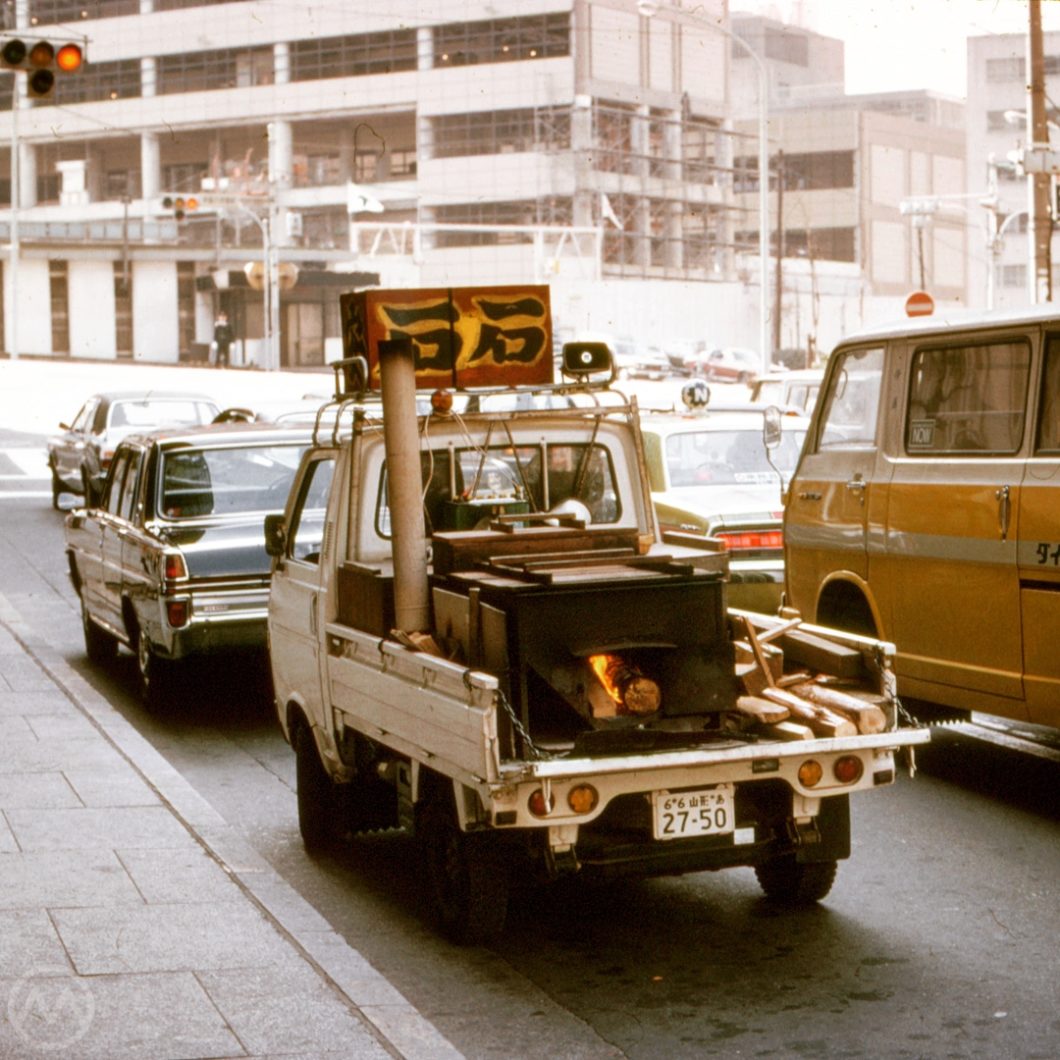Feeling down? Need some comfort food? Don’t worry, the Yaki Imo man is here to help. In this flashback, we take a trip through the OldMotors archives to Japan, circa 1976, and this Suzuki Carry L61.
Although we usually focus on the car, what’s in the pickup bed here is just as important. This is a food truck. That is a real wood-fueled fire less than three feet from the gas tank. In the big black box above it is Yaki Imo – stone-baked sweet potatoes, a Japanese street snack usually seen in the winter months.
Yaki Imo
The Yaki Imo man is just as much of a fixture in autumn and winter in Japan as the Ice Cream truck is in American summer. The European analog might be a guy selling gelato in Bergamo from a Piaggio Ape. A second car battery between the cooker and the cab is hooked up to a big loudspeaker, out of which is no doubt blasting “Ishi yaaaaaaaa ki imooo!”
Yaki Imo trucks replaced Yaki Imo carts (which appeared in the late 19th century) starting in the 1940s. No doubt proprietors were grateful not to have to lug around a cast iron roaster and firewood or charcoal anymore.
The “Keitora” – Kei Truck – is perfect for the Yaki Imo Man or Woman. They are cheap to run, own, and insure. They take up as little space as possible – a real factor in Japan – and starting in the mid-1960s they took maximum advantage of the Kei formula. They make a perfect vehicle for a street-born restaurant selling ¥320 (about $3) snacks. And they are good snacks.
Yaki Imo trucks generally have a considerable layer of insulation between the metal roaster and the mechanical parts of the truck for safety. North American or European officials might frown on such an arrangement, but there haven’t ever been any serious disasters. Operators typically don’t keep the fire going while the truck is en route somewhere, but they do drive around the neighborhood, usually warbling their song from a microphone routed to a speaker.
A Little Kei History
Japan created the “Kei” class of vehicles in 1949, setting up a group of distinct tax and licensing advantages over traditional vehicles (at that time mostly sourced from Europe) in hopes of stimulating domestic car production and ownership.
Key to making the vehicles affordable and useful in Japan’s densely populated areas was placing limits on length, width, and displacement. The cars were intended to be affordable to ordinary Japanese and small and simple were the order of the day. It took, however, about a decade of tinkering with the formula to get it to the point where somebody could actually produce a car that consumers would want to buy. The engine displacement limit was set to 360cc in 1955.
As with larger vehicles in Japan, Trucks came a little sooner, because there’s always a need for commercial trucks.
The first modern Kei truck, the forward-control Kurogane Baby, appeared in 1959. This little truck did not last long and is almost entirely unknown outside of Japan, but the forward-control layout was the first to really maximize the dimensions set up in the rule book. Why waste any space ahead of the driver?
By 1966, virtually all the Keitoras were forward control, and in the 1970s they started to look very much alike, since they were all built to the same class dimensions. It was pretty much front end and cab styling that set apart a Daihatsu Hijet from a Subaru Sambar or a Honda TN360.
Suzuki’s version of the idea, the Carry, was often the best-selling truck in Japan – a pint-size F-series in its way. In 1969, Suzuki injected some style with the help of Giorgetto Giugiaro for the fourth-generation Carry, then replaced that truck with an updated version in 1972. That’s the one our Yaki Imo vendor chose – an L61. L60s had fixed beds where only the tailgate opened, L61s used the more popular drop-side setup.
Back then, power still came from 359-cc two-stroke twin, but the days of the 360-cc Kei were numbered. The trucks still sold alright – but Kei car sales cratered in the mid-1970s as emissions rules robbed the little 360s of what power they had and Japanese buyers increasingly wanted larger and fancier cars. The formula was upped to a maximum limit of 550-cc in 1975. With the Carry due for a redesign in 1976, the L60/61 stayed pretty much the same until that redesign arrived.
After going to four-stroke engines, the Carry formula continued more or less unchanged (but with continuous tech updates and periodic chassis redesigns) into 1999, when crash regs moved the engine backward and the trucks got a somewhat different look. The engine formula grew to 660-cc in early 1990.
Street Scene
It’s not clear where exactly in Japan this scene is, but the other cars are a surprising potpourri of fancy cars in Japan at the time – a Ford Taunus TC Coupe is at the far front with a exotic-for-Japan mid-1970s Plymouth Fury behind, an A30-series Nissan Gloria just ahead of the Carry, an S60 Toyota Crown cab alongside, and an Isuzu Elf behind.
Tons of comfort food for the car spotter and snacks too, what’s not to like?

